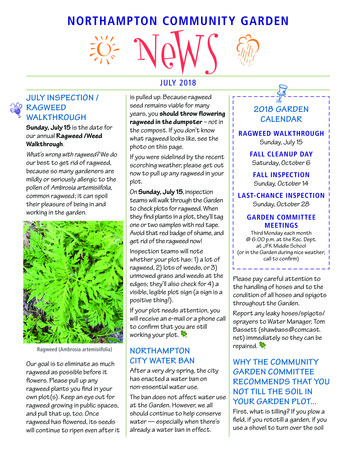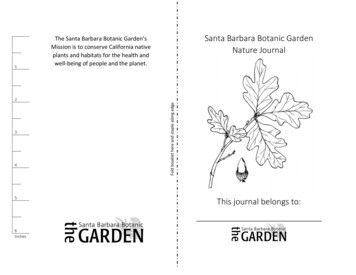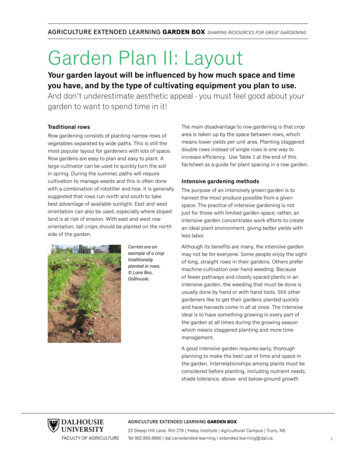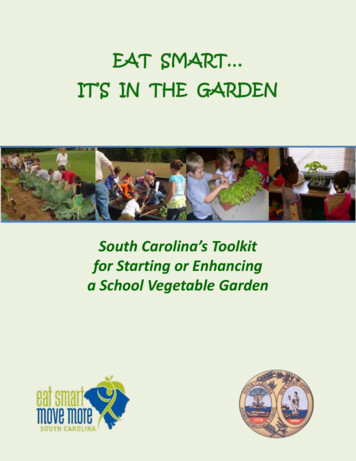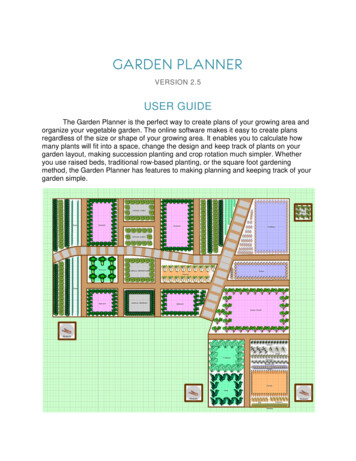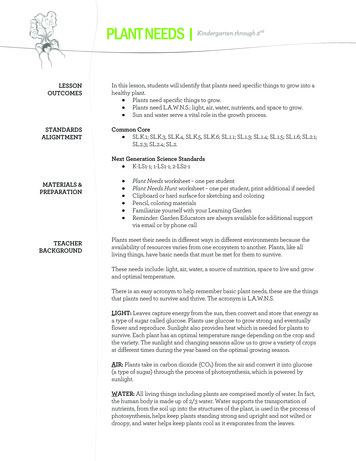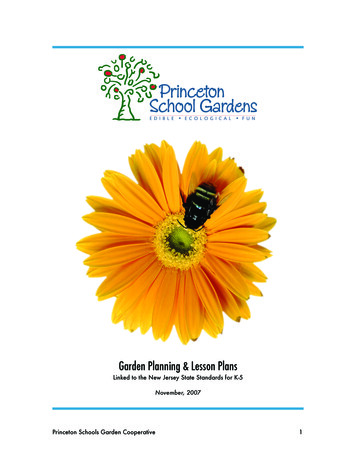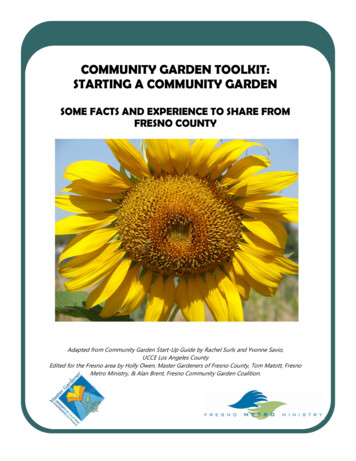
Transcription
COMMUNITY GARDEN TOOLKIT:STARTING A COMMUNITY GARDENSOME FACTS AND EXPERIENCE TO SHARE FROMFRESNO COUNTYAdapted from Community Garden Start-Up Guide by Rachel Surls and Yvonne Savio,UCCE Los Angeles CountyEdited for the Fresno area by Holly Owen, Master Gardeners of Fresno County, Tom Matott, FresnoMetro Ministry, & Alan Brent, Fresno Community Garden Coalition.
Page 1Here in the Central Valley we are blessed with a year-round growingseason, and people have many reasons to be interested in foodproduction gardening. Some want to save money on their food bills.Others like the freshness, flavor and wholesomeness of home-grownproduce. For many, gardening is a relaxing way to exercise and enjoybeing outdoors. Many families living in the city would like to grow theirown fruits, vegetables, herbs, and flowers, also many city children areunaware of how food gets to their table. As well, there are families fromother cultures who would like a place to grow traditional foods notavailable in the supermarket.With the advent of modern urban planning and land prices, manypeople have newer houses on smaller-size lots. Association rules,codes, and ordinances may prohibit visible vegetable gardening. Publicgreen spaces are often scattered and used by many different parties.One way to provide space for gardens is to explore a communitygarden concept.Community gardens beautify neighborhoods and help bring neighborscloser together. Gardens have proven to be useful in reducingneighborhood crime. Particularly when vacant, blighted lots aretargeted for garden development. Community gardens provide safe,recreational green space in urban areas with little or no park land, andcan contribute greatly to keeping urban air clean.
Page 2Step by Step to your own Community borhood InvolvementForm an Organizing CommitteeFind some LandIdentifying the Land OwnerWhat about Water?Contact the Land OwnerGet the Soil TestedVisit the Planning DepartmentSigning the LeaseObtaining Liability InsurancePlanning the GardenCreating a Garden BudgetWhere to get Materials & MoneyGarden InfrastructureGet Growing!Celebrate!
Page 31. Get Your Neighbors InvolvedThere is a lot of work involved in starting a new garden. Make sure you have several people who will help you.Over the years, experience indicates that about ten interested parties is a good starting number to create andsustain a garden project.Survey the residents of your neighborhood or the surrounding proposed area to inform them of your idea andsee if anyone is interested and ask them if they would want to participate. Hold monthly meetings of theinterested group to develop and initiate plans, keep people posted on the garden's progress, and keep theminvolved in the process from day one.2. Form an Organizing CommitteeAn organizing committee will help you make decisions with collaboration and will help to divide up the workeffectively. As well, it will be crucial when navigating the city requirements for starting the garden. It can beformed at any time during the process of starting a community garden; however, it's wise to do so early on. Thisway, club members can share in the many tasks of establishing the new garden. The typical garden club willhave many functions, including:* Establishing garden rules (see sample)* Acting as garden liaison to the city* Accepting and reviewing gardenapplications* Making plot assignments* Collecting garden dues (if any)* Paying bills such as water and the lease* Resolving conflictsThe typical community garden organization hasat least two officers: a president and atreasurer, although you may need or want morethan that. Elections are the common way toensure that the process stays a representativeone and doesn’t leave everything up to just oneor two people all the time.3. Find LandLook around your neighborhood for a vacant lot that gets plenty of sun--at least six to eight hours each day. Agarden site should be relatively flat (although slight slopes can be terraced). It should be relatively free of largepieces of concrete left behind from demolition of structures. Any rubble or debris should be manageable--thatis, it can be removed by volunteers clearing the lot with trash bags, wheelbarrows, and pickup trucks. Ideally, itshould have a fence around it with a gate wide enough for a vehicle to enter. It is possible to work with a sitethat is paved with concrete or asphalt by building raised beds that sit on the surface or using containers. Youcan also remove the asphalt or concrete to create areas for gardens, but such a garden will be much moredifficult, expensive, and time-consuming to start. A site without paving and soil relatively free of trash and debrisis best. Once the trash is removed, till the under the weeds in order to preserve the topsoil. Remember; don’tdo this until you have permission from the land owner.The potential garden site should be within walking distance, or no more than a short drive from you and theneighbors who have expressed interest in participating. If the lot is not already being used, make sure thecommunity supports establishing a garden there.It's best to select three potential sites in your neighborhood and write down their address and nearest crossstreets. If you don't know the address of a vacant lot, get the addresses of the properties on both sides of the
Page 4lot--this will give you the ability to make an educated guess on the address of your site. We suggest you identifyat least three potential sites because one or more might not be available for you to use for various reasons, andyou want to end up with at least one that works out.4. Find out Who Owns the LandIt is illegal to use land without obtaining the owner’s permission. In order to obtain permission, you must firstfind out who owns it.Contact your local City Hall and find out what department keeps information pertaining to land and the landowners. In Fresno, visit the Hall of Records. The address is 2281 Tulare St. Rm 201, Fresno, 93721. Speakto the person at the main counter, and give them the address of the parcel or parcels you are interested in. Ifyou have only a few addresses, they will look it up for you. If you have a lot, there is a computer and map thatyou can use to find your information. The phone number is (559)488-3534 and office hours are 9AM – 4PM,Monday through Friday.5. What About Water?While you are researching site ownership, contact the water service provider in your area to find out if yourpotential site(s) has/have an existing water meter to hook into. In Fresno, this is the City of Fresno WaterDivision, located at 1910 E. University Ave., Fresno 93703. The phone number is (559)621-5300 and officehours are 8AM – 5PM, Monday through Friday. Call your water provider's customer service department, andask them to conduct a "site investigation". They will need the same location information that you took with youto the Hall of Records.Existing access to water will make a critical difference in the expense of getting your project started. Usually, ifthere is already water on site, with the land owner’s permission you can just open an account with the PublicUtilities Division and start watering your garden. You may need to have an upgraded water meter installed, butthat will be information that the Water Division can either give you or they can direct you to the properdepartment to get one installed. If there has never been water service to that site, you will need to hire acontractor to connect a water line to the city main water line. This project will need permits.6. Contact the Land OwnerOnce you have determined that your potential site is feasible, write a letter to the landowner asking forpermission to use the property for a community garden. Be sure to mention to the landowner the value of thegarden to the community and the fact the gardeners will be responsible for keeping the site clean and weedfree (this saves landowners from maintaining the site or paying city weed abatement fees).Establish a term for use of the site, and prepare and negotiate a lease. You should attempt to negotiate a leasefor at least three years (or longer if the property owner is agreeable). Many landowners are worried about theirliability for injuries that might occur at the garden. Therefore, you should include a simple "hold harmless"waiver in the lease and in gardener agreement forms, and begin looking for liability insurance.7. Get Your Soil TestedIt might be advisable to have the soil at the site tested for basic fertility, pH, and presence of heavy metals.Depending on what you are testing for, a soil test can cost between 30 and 150 from private labs. Lists oflabs are available by contacting the Natural Resources Conservation Service (NRCS) for the Fresno area at(559)276-7494. Even if you are outside of the Fresno area, they can point you in the right direction. Here are afew things to look for that may send you to another parcel: Heavy metals, PCB’s, motor & heating oil, asbestos,sewage, coli form & E. coli.8. Visit the Planning DepartmentThe information in this section is intended for gardens that are to be built in the future. Right now, the City ofFresno is undergoing changes to it’s zoning codes. Community Gardens are not currently listed under any
Page 5zoning, but this is being addressed in the upcoming changes. Now that you have found out who owns the landand received permission to use it, established that there is water on site, and tested the soil to find out it is safe,you need to go to the City and pick up an application for land use from the City Planning Department. This willhelp guide you on the next steps. In Fresno you will visit the Planning Division on the third floor of City Hall,located at 2600 Fresno St.,Fresno, CA 93721. If you havequestions, the phone number is(559)621-8277. If you areoutside of Fresno, contact yourlocal City Hall for your localprocedure.9. Signing a LeaseLandowners of potential gardensites might be concerned abouttheir liability should someone beinjured while working in thegarden. Your group should beprepared to offer the landowner alease with a "hold harmless"waiver. This "hold harmless"waiver can simply state that,should one of the gardeners beinjured as a result of negligenceon the part of another gardener,the landowner is "held harmless"and will not be sued. Eachgardener should be made awareof this waiver and should berequired to sign an agreement in order to obtain a plot in the community garden. As well, the land owner mayrequire proof of liability insurance prior to signing the lease.10. Obtaining Liability InsuranceIt is a good idea to look into obtaining some form of liability insurance for your garden. It is quite likely that theland owner will require it. There are several kinds of policies to consider. The most basic is called CommercialGeneral Liability, which covers bodily injury and property damage to a third party caused while that third party isinjured while on the gardening and/or community garden premises.If your garden has a board with a director and board members, another policy to consider is a professionalliability called Director and Officers Liability. There are others that may fit your needs, so discuss your needswith your fellow gardeners and ask your agent lots of questions to find the policy that fits your garden.For information on a variety of policies, contact Beth Allen ant Nickerson Insurance Services. She is located inLomita, CA and works with several community gardens on their insurance needs. Her phone number is (310)326-6335 ext. 143 and her email is beth@nickersonins.comOnce you have a lease signed by the landowner, obtained liability insurance, and have city approval, you'refree to plan your garden!11. Planning the GardenCommunity members involved in the garden should be involved in the planning, design, and set-up of thegarden. Before the design process begins, you should measure your site and make a simple, to-scale site map.Hold two or three garden design meetings at times when interested participants can attend. Make sure thatgroup decisions are recorded in official minutes, or that someone takes accurate notes. This ensures thatdecisions made can be communicated to others, and progress will not be slowed. A great way to generateideas and visualize the design is to use simple drawings or photos cut from garden magazines representing the
Page 6different garden components--flower beds, compost bins, pathways, arbors, etc.--that can be moved around onthe map as the group discusses layout.12. Creating a Garden BudgetUse your design to develop a materials list and cost-out the project. You will need to call-around to get priceson fencing and other items. You might be surprised at the cost. A community garden with just the BasicElements (listed above) typically costs between 2,500 to 7,000. At this point, your group might decide toscale back your initial plans and save some design ideas for a "Phase Two" of the garden. Keep in mind thatimprovements to the garden can be done over time. If you don’t HAVE to have raised beds, don’t spend themoney on lumber.13. Where to Get Materials and MoneyWhile some start-up funds will be needed through determination and hard work, you can obtain donations ofmaterials for your project. The Fresno Community Garden Coalition can help connect you with communitybusinesses that might assist by providing anything from fencing to lumber to plants. The important thing is toask. Develop a letter that tells merchants about your project and why it's important to the community. Attachyour "wish list", but be reasonable. Try to personalize this letter for each business you approach. Drop it offpersonally with the store manager, preferably with a couple of cute kids who will be gardening in tow, then,follow-up by phone. Be patient, persistent, and polite. Your efforts will pay-off with at least some of thebusinesses you approach. Be sure to thank these key supporters and recognize them on your garden sign, at agarden grand opening, or other special event. Don’t forget to think outside the box on this one. Contractorsand construction companies always have a ton of scrap and materials that just get thrown away. For instance,if you know of a friend or relative who is replacing an old shabby fence, ask them to give you the old fencewood if you haul it away. It makes great barriers for raised beds, work benches, compost bins, etc.Money, which will be needed to purchase items not donated, can be obtained through community fund-raiserssuch as car washes, craft and rummage sales, pancake breakfasts, and bake sales. They can also be obtainedby writing grants, but be aware grant writing efforts can take six months or longer to yield results, and you musthave a fiscal sponsor or agent with tax-exempt 501(c)3 status (such as a church or non-profit corporation) thatagrees to administer the funds.14. Garden InfrastructureIf you have not yet formed a Garden Committee, now is the time to do so. It's also time to establish gardenrules, develop a garden application form for those who wish to participate, set up a bank account, anddetermine what garden dues will be if these things have not already been done. This is also the time to beginhaving monthly meetings if you have not already done so. Also, if you haven't already contacted your citycouncilperson, he or she can be helpful in many ways including helping your group obtain city services such astrash pick-up. Their staff can also help you withcommunity organizing and soliciting for materialdonations.15. Get Growing!Many new garden groups make the mistake ofremaining in the planning, design and fundraisingstage for an extended period of time. There is a fineline between planning well and over planning. Afterseveral months of the initial research, designing,planning, and outreach efforts, group members willvery likely be feeling frustrated and will begin towonder if all their efforts will ever result in a garden.That's why it's important to plant something on yoursite as soon as possible. People need to see visibleresults or they will begin to lose interest in the project.
Page 7To keep the momentum going, initiate the following steps even if you are still seeking donations and funds oryour project (but not until you have signed a lease and obtained insurance). Don’t let the lack of a toilet or dripirrigation system keep you from planting.a.Clean up the SiteSchedule community workdays to clean up the site. How many work days you need will dependon the size of the site, and how much and what kind of debris are on site.b.Install the Irrigation SystemWithout water, you can't grow anything. So get this key element into place as soon as possible.There are plenty of opportunities for community involvement--from digging trenches to laying outPVC pipes.c.Plant SomethingOnce you have water, there are many options for in-garden action. Stake out beds and pathwaysby marking them with stakes and twine. Mulch pathways (the cheapest way to do this is to find alandscaping crew and have them drop off their lawn clippings at the end of every day. The grasswill keep weeds from growing and will work just fine until a more permanent solution can be setup.) If your fence isn't in yet, some people might still want to accept the risk of vandalism and gettheir plots started. You can also plant shade and fruit trees and begin to landscape the site. If youdo not yet have a source of donated plants, or don't wish to risk having them vandalized, plantannual flower seeds which will grow quickly and can be replaced later. There are manyorganizations and stores that get rid of old seeds. The packages have a sell by date, but quiteoften they will still germinate.d.Keep it Going
Page 8As materials and funds become available, take a vote on what to add to the garden. Tools, art,structure upgrades, etc. are all things that can come as the garden grows.15. Celebrate!At this point, your ideas and hard work have finally become a community garden! Be sure to take time tocelebrate. Have a grand opening, barbecue, or some other fun event to give a special thank-you to everyonewho helped to make this happen. This is the time to give all those who gave donated materials or time aspecial certificate, bouquet, or other form of recognition. Pat yourselves on the back while you are at it!Troubleshooting as the Garden DevelopsAll community gardens will experience problems somewhere along the way. Don't get discouraged--getorganized. The key to success for community gardens is not only preventing problems from ever occurring, butalso working together to solve them when they do inevitably occur. In our experience, these are some of themost common problems that "crop-up" in community gardens, and our suggestions for solving them1. VandalismMost gardens experience occasional vandalism. The best action you can take is to replant immediately.Generally the vandals become bored after a while and stop. Good community outreach, especially to youth andthe garden's immediate neighbors is also important. Give out some extra produce to the neighbors to showyour willingness to be a part of the community. Most important, don't get to discouraged. It happens. Get over itand keep going. What about barbed wired or razor wire to make the garden more secure? Our advice--don't.It's bad for community relations, looks awful, and is sometimes illegal to install without a permit. If you needmore physical deterrents to keep vandals out, plant bougainvillea, holly, cactus or pyracantha along your fence,their thorns will do the trick! Another idea is to plant a vandal’s garden along the outside fence line for thosewho are just too tempted by your bounty to resist.2. PoliceInvite the community officer from your local precinct to a garden meeting to get their suggestions on making thegarden more secure. Community officers can also be a great help in solving problems with garden vandalism,dealing with drug dealers, and gang members in the area. The officers in your neighborhood will welcome thecultivation of any empty lot and they appreciate positive community activity just like you do. It makes their jobeasier and may increase their number of passes by the garden.3. CommunicationClear and well-enforced garden rules and a strong garden president can go a long way towards minimizingmisunderstandings in the garden. But communication problems do arise. It's the job of the Community Gardento resolve those issues. If it's something not clearly spelled out in the rules, the membership can take a vote toadd new rules and make modifications to existing rules.Language barriers are a very common source of misunderstandings. Community Garden leadership shouldmake every effort to have a translator at garden meetings where participants are bilingual--perhaps a familymember of one of the garden members who speaks the language will offer to help. Fresno Metro Ministry canalso connect gardens with local translators for meetings or resolving disputes between gardeners.4. Trash
Page 9It's important to get your compost system going right away and get some training for gardeners on how to useit. If gardeners don't compost, large quantities of waste will begin to build up, create an eyesore, and could hurtyour relationships with neighbors and the property owner. Waste can also become a fire hazard. Make suregardeners know how to sort trash properly, what to compost, and what to recycle. Trash cans placed inaccessible areas are helpful to keep a neat and tidy garden.5. Gardener Drop-OutThere has been, and probably always will be, a high rate of turnover in community gardens. Often, people signup for plots and then don't follow through. Remember, gardening is hard work for some people, especially in theheat of summer. Be sure to have a clause in your gardener agreement which states gardeners forfeit their rightto their plot if they don't plant it within one month, or if they don't maintain it. While gardeners should be givenevery opportunity to follow through, if after several reminders either by letter or phone nothing changes, it isMaster Gardeners of Fresno Countyhttp://groups.ucanr.org/mgfresno/Helpline: (559)456-7563Fresno Community Garden Coalitionwww.fresnocgc.orgFresno Metro Ministry1055 N. Van Ness Ave., Suite HFresno, CA 93728(559)485-1416http://fresnometmin.orgCity of Fresno Planning DepartmentPlanning DepartmentCity Hall2600 Fresno St.Fresno, CA 93721(559)621-8277www.fresno.govCity of Fresno Water Division1910 E. University Ave.Fresno 93703(559)621-5300www.fresno.govHall of Records2281 Tulare Street, Room 302Fresno, CA 93721(559)488-3476Natural Resources Conservation Service (NRCS)Fresno Service Center4625 W. Jennifer Ave., Suite CFresno, CA 93722(559)276-7494www.ca.nrcs.usda.govAmerican Community Garden Associationhttp://communitygarden.org
Sample FormsCommunity Garden ContractRules, Terms, and Conditions for ParticipationIntroductionThe (organization/garden manager) is the highest governing authority at the (GardenName) Community Garden.Breaking any rules, terms, and conditions is cause for exclusion from the garden andloss of your plot.1. You will receive one verbal warning from the garden manager.2. If no response or correction has been made, you will receive written notice two weeks later.3. In another two weeks, if no response or correction has been made, you will receive writtenfinal notification that you have forfeited your gardening privileges and plot.4. You will be allowed to reapply for another garden plot only after one year, and only at thediscretion of the garden manager.Rules, Terms, and Conditions for ParticipationIf accepted as a gardener, I will abide by the following rules, terms, and conditions:1. I use this garden at the sole discretion of (Garden Name) Community Garden. I agree toabide by its policies and practices.2. The fee for the use of the garden is ( ?) per plot, per year (January 1 – December 31), dueon or before (January 1). Fee for half a year after (beginning July 1 or later) is ( ?). There areno refunds.3. Once I have been assigned a plot, I will cultivate and plant it within two weeks. I will gardenyear round. My plot cannot be left fallow or unused for any period of three weeks or longer,more than one time a year.4. My plot is (20 x 20) feet. I will not expand my plot beyond this measurement or into paths orother plots. I will keep all my plants within the limits of my garden plot and will not allow anyplants to grow more than six feet high. I must keep my plot free of weeds, pests and diseases.5. I will keep my plot, paths, and surrounding areas clean and neat. I will completely separatemy trash into three groups: 1) dead plants, leaves, and other green waste plant parts; 2) rocks,stones, and asphalt; and 3) paper, plastic, cardboard, wood, metal, etc. I will put each type oftrash only in the areas designated specifically for each. Anything I bring from my home I willtake back home. I will not bring household trash and leave it at the (Garden Name) CommunityGarden.6. If I now have more than one plot, I will give up my additional plots by the end of this gardening year (December 31).7. I will not plant any illegal plant. I will not smoke, drink alcoholic beverages, use illegal drugs,or gamble in the garden. I will not come to the garden while under the influence of alcohol orillegal drugs. I will not bring weapons or pets or other animals to the garden.8. Guests and visitors, including children, may enter the garden only if I accompany them.They must follow all rules, terms, and conditions stated here. I will supervise my children at alltimes when they are in the garden. I am solely responsible for the behavior of my guests.9. The garden manager will assign me general garden maintenance tasks each month, and Imust complete them by the end of the month that I am assigned them.
10. I will water my plot according to water-wise guidelines. (If I use more than the recommendedamount of water, I will pay a fee each month to cover the cost of this additional water.11. I will attend the regular (bi-monthly) garden club meetings. If workshops are offered, I will attend at least one on each of the following topics: soil preparation and maintenance, watering thevegetable garden, and pest and disease control.12. I will not apply any pesticides in the garden without the approval of the garden manager.13. I will not make duplicate keys of any locks at the garden or give my key or lock combinationto another person.14. I will not take food or plants from other gardeners’ plots. I will not take anything from the garden that is not rightfully mine.15. I will respect other gardeners, and I will not use abusive or profane language or discriminateagainst others.16. I will work to keep the garden a happy, secure, and enjoyable place where all participantscan garden and socialize peacefully in a neighborly manner.17. I forfeit my right to sue the owner of the property.CommitmentI have read and understand the application and accept these rules, terms, and conditions statedabove for the participation in the (Watts Family) Community Garden.Signed: Date:GardenerApproved: Date:Garden ManagerThis is a pretty good guideline. Remember, your organizing committee will help to determine what the rules and guidelines should be. Start simple and hold gardeners accountable. Set up fees according to the budget of the garden, discuss length of contracts and fee payment schedules, plot size, individual gardener responsibilities, etc. Itis best to lay everything out and come to agreements with the organizing committeeprior to signing up gardeners.Here are a few options to think about: Sliding fee scale based on income, Different size plots with different fees, Amount of whole garden involvement that will be required of each gardener, How much mandatory involvement with the garden should be required by each gardener, What are the steps taken to revoke a plot assignment and remove a gardener fromthe garden?Get creative and be open to many different ideas. Remember, this is a garden of, by,and for the gardeners, so it can be set up in unlimited kinds of ways.
Sample Form: Garden Plot RegistrationName DateAddressCity ZipPhone (home) (work)Did you have a garden plot with this community garden last year?Yes NoIf yes, do you want the same garden plot this year?Yes NoIf no, what area of the garden would you like to be in?A plot fee of is required before the plot can be assigned. This fee will go toward expensesof the community garden (water bills, plant/seed purchases, community tools, etc.).A clean-up deposit of is required before the plot can be assigned. The clean-up depositwill be returned in the fall after you have removed all of your plants and cleaned your plot.Please mark three areas that you would be interested in volunteering with during the season. Each gardener is expected to help during the season with general chores.Site maintenancePhone callsMailingsAssigning plotsPath maintenanceConstruction projectsWateringAnnual plantingFall cleanupCompostingSocial eventsI have read the Community Garden Rules and understand that failure to meet the guidelines willresult in loss of cleanup deposit fees and gardening privileges.Signature Date
Sample Form: Garden Rules and RegulationsGarden rules should be established for every community garden. Rules are an excellent way to ensure everyone understands how the garden will operate and what is expected of each gardener. These rules are intended as a guide only. Each garden's rules will vary depending on the ne
garden to the community and the fact the gardeners will be responsible for keeping the site clean and weed-free (this saves landowners from maintaining the site or paying city weed abatement fees). Establish a term for use of the site, and prepare and negotiate a lease. You should attempt to negotiate a lease
